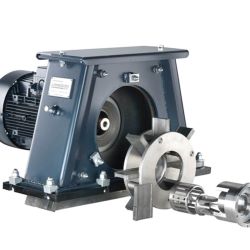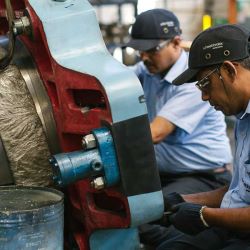The upper and lower spray bridges in Wheelabrator’s high-performance systems are often equipped with 4 spray nozzles each in order to cover a wide spray zone. The spray bridges can move up to 2m/s, brake at the deviating point and accelerate back in the other direction, often 24 hours a day.
Handling Overspray
Wheelabrator uses a spray chamber, with oscillators mounted upstream of the chamber. This means that the chamber largely consists of smooth, straight walls. They are coated entirely with Teflon film and dried overspray can simply be swept off this film. Depending on the size of the machine, the overspray can be removed from one or both sides by a pre-filter coated with Teflon film. This innovative system means that long sessions of machine downtime to clean the walls are avoided.
It is only then that any remaining (largely dry) paint dust can pass into the filter system. The system is equipped with special Tefloncoated cartridges to ensure long-term dust removal from waste air to a residual dust content of ≤ 2mg/m3³.
If solvent-based paints are used, these release gases that can naturally not be filtered out by a dust filter. Thermal, catalytic or activated carbon filtration systems can be used here (VOC systems).
Drying Chamber & Slat Conveyor
The preserved steel plates and profiles are dried continuously here. The drying chamber can be heated by the exhauste air from the pre-heater, so that even paints with long drying times (such as water-based paints) can be dried quickly. Additional circulation of high quantities of air accelerates the drying process. If a pre-heater does not need to be operated all year round, you can also use a self-sufficient heating system as an alternative or addition.
Workpieces are transported through the drying chamber on a slat conveyor. The greatest possible distance between the spray zone and the slat conveyor reduces unavoidable contamination with overspray. To prevent the bending of thin plates, an elevating roller is positioned upstream in order to balance out height differences and ensure that the plates are transferred smoothly onto the conveyor cross slats. The plates only rest on the support points of the conveyor cross slats, which means there are very few points of contact with the workpiece. The wet primer remains largely undamaged as a result.
The length of the drying chamber varies depending on the type of paint, coating thickness and passage speed.
It is vital to select the correct drive as the load on this can be very high. The right layout of the drive shaft, drive and gear ratio will ensure the even running of the slat conveyor.
Outlet Roller Table
The last section is the outlet roller table. The preserved steel plates and profiles are discharged here.
The outlet roller table can be equipped with a cross transfer conveyor to optimise efficiency or connect it to a logistics system.


